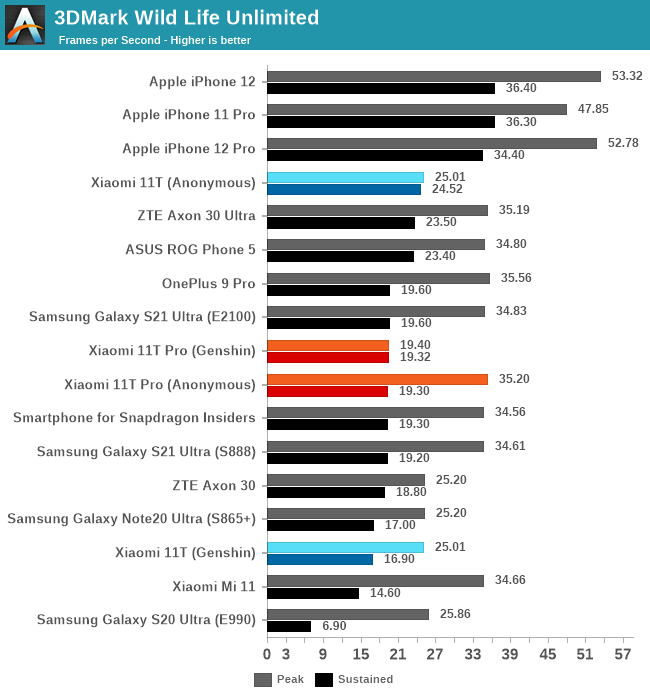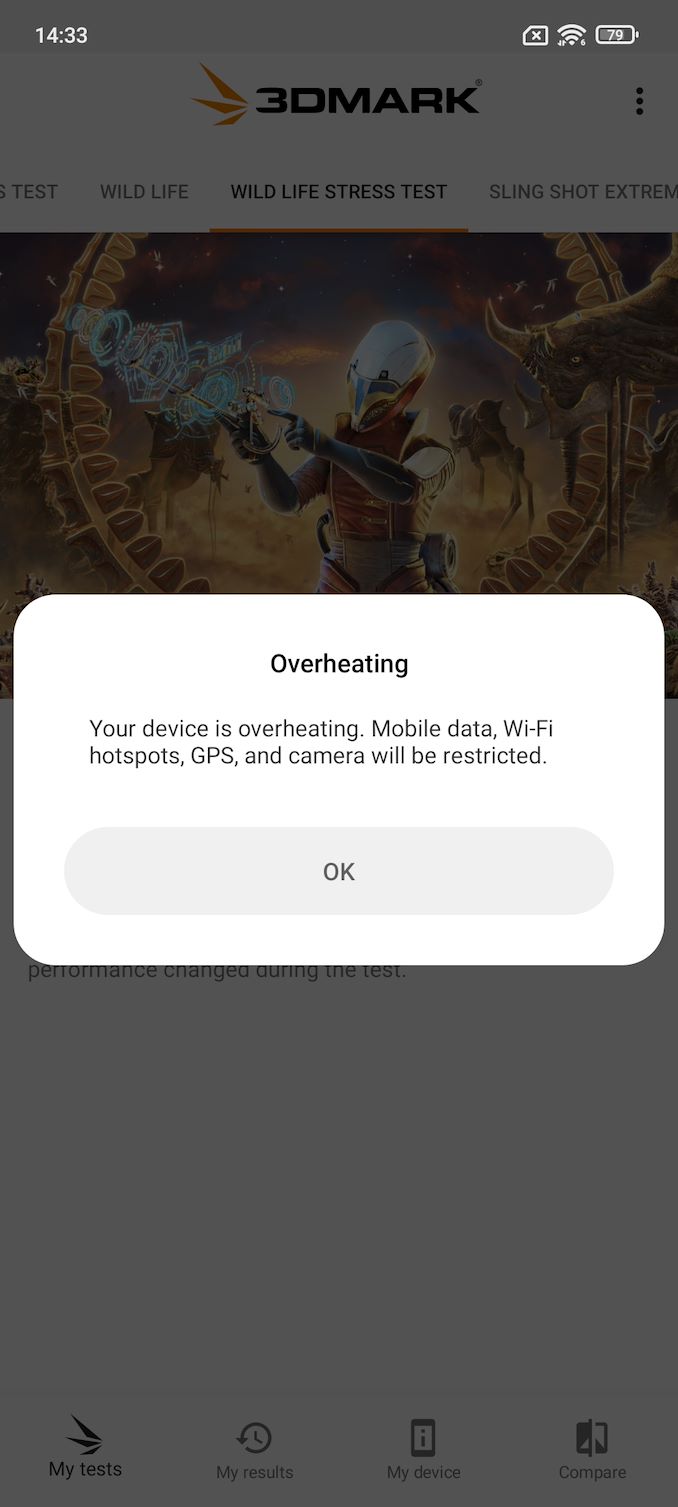The Xiaomi 11T & 11T Pro Review: Two Chips, With a Battery Focus
by Andrei Frumusanu on September 15, 2021 9:00 AM EST- Posted in
- Mobile
- Smartphones
- Xiaomi
- Xiaomi 11T
- Xiaomi 11T Pro
GPU Performance - More "Optimisations"
On the GPU side of things, it’s again a very interesting to match up the Snapdragon 888 versus the Dimensity 1200. The Snapdragon should dominate in peak performance, however sustained is another question.
Unfortunately, the 11T Pro here is again a Snapdragon Xiaomi device like many that we’ve seen in the past – the issue here being is that the phone just outright doesn’t throttle at all. In anonymous applications, the phone will go full power no matter the temperature until at some point it’ll give out an overheating warning.
The MediaTek 11T also didn’t throttle at all, and although the phone reached 47°C at least it didn’t give off any overheating warning.
Lately I’ve been spoofing our workloads as popular games, specifically Genshin Impact, given it’s the most popular and most demanding real world gaming title out there. Benchmarking the game itself is hard because of the dynamic resolution and differing graphics settings depending on devices, but spoofing a standardised workload as the game work well to showcase representative gaming performance.

Unfortunately, this experiment here showcases Xiaomi’s shenanigans:
First off with the MediaTek 11T: the anonymous test doesn’t throttle at all and peak and sustained performance figures are essentially the same, with the chip actually faring quite well here in sustained performance, not accounting for the hot phone.
In the Genshin spoofed test, the device has drastically lower thermal behaviour, and throttles at lot quicker to lower performance states. He phone was generally only 39°C warm which was very good.
On the Snapdragon 11T Pro, there’s quite the shocking revelation; the phone is outright capping peak performance, gutting it to otherwise the sustained performance levels of the anonymous version (before the overheating warning).
Thermals of the phone here are excellent at only around 37°C peak skin temperatures. Generally, the prolonged gaming performance here isn’t changed as the both end up at the same level.
The problem with this “optimisation” is of course that it’s completely misleading the benchmarks. If real games are actually severely limited in GPU frequency and performance, then this should also be represented in benchmarks for transparency.
I’m very exhausted by these opaque mechanisms, because most other reviewers will likely not catch them, which is likely Xiaomi’s goal. It’s a crap industry behaviour that needs to be abolished.
I’m skipping over the rest of the benchmarks here as it’s not even worth showcasing.











41 Comments
View All Comments
arayoflight - Wednesday, September 15, 2021 - link
The battery life test of D1200 phone is rather surprising. The OnePlus Nord 2 which uses the same chipset does pretty well in GSMArena's battery test: https://fdn.gsmarena.com/imgroot/reviews/21/oneplu...yeeeeman - Wednesday, September 15, 2021 - link
Yep, I suspect this is a xiaomi thing, not something really bad with the soc, as I would expect mediatek engineer to be able to test power consumption of their soc before releasing it to the market.flipp0 - Thursday, September 16, 2021 - link
Yes, I had the Nord 2 and battery life was great. I think it is likley that anandtech got a faulty 11T unit or that 11T has some kind of software bug draining the battery. I am suprised that Andrei does not mention this a possible explanation for the results reported in this review.Spunjji - Monday, September 20, 2021 - link
Crappy software. Glad to see they fixed it, but that was pretty poor to be releasing a review unit in such a bad state.eastcoast_pete - Wednesday, September 15, 2021 - link
Thanks for the test, especially taking a close look at power management of the SoCs! I guess the overheating issue with the 888 indicates both the appetite of the X1 for power, and the need for good thermal design when used in a close, confined space like a Smartphone. Almost looks as if Xiaomi assumed that designs for older, lower powered SoCs would work just fine with the 888, and was in for a nasty surprise when it didn't.It's too bad that Xiaomi seems to then insist on "improving" these phones with their idea of enhancement by software, which clearly doesn't work. Those results for the Dimensity are also surprising, and not in a good way.
The temperatures measured remind me of an old phone with the SD 808 many years ago; probably the worst SoC QC I ever had the displeasure of owning.
shabby - Wednesday, September 15, 2021 - link
Interesting to see the price difference when the only difference is the soc, Qualcomm sure charges a premium.shabby - Wednesday, September 15, 2021 - link
But ouch that battery life, shirley some software updates might fix this?Spunjji - Monday, September 20, 2021 - link
And they did!PEJUman - Wednesday, September 15, 2021 - link
Curious if Xiaomi is using 'power' cells instead of 'energy' cells on their phones. Or if they are simply pushing energy cells with obscene C rates (at 4V * 4Ah, that's a mere 16 Wh of energy capacity), charging this at 100+ Watts to full is basically 6+ C charging rates.Either they have great battery tech, not sure who is their supplier for these... or the customer will just have to contend with rapid aging of their battery as they fast charge it everyday.
DanNeely - Wednesday, September 15, 2021 - link
Killing batteries early goes right with making battery replacement difficult as a means to drive more sales of new phones.